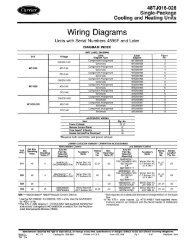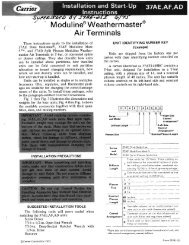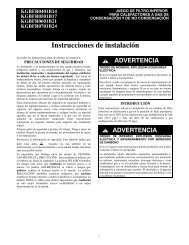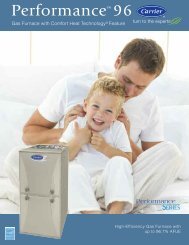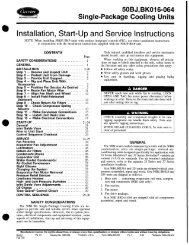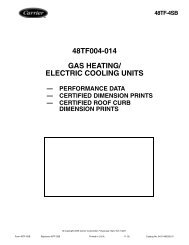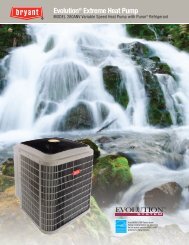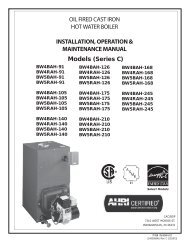Start-Up, Operation, and Maintenance Instructions
Start-Up, Operation, and Maintenance Instructions
Start-Up, Operation, and Maintenance Instructions
You also want an ePaper? Increase the reach of your titles
YUMPU automatically turns print PDFs into web optimized ePapers that Google loves.
HFC-134a should not be mixed with air or oxygen <strong>and</strong><br />
pressurized for leak testing. In general, this refrigerant<br />
should not be present with high concentrations of air or<br />
oxygen above atmospheric pressures, because the mixture<br />
can undergo combustion.<br />
TESTING WITH REFRIGERANT TRACER — Use an environmentally<br />
acceptable refrigerant as a tracer for leak test<br />
procedures. Use dry nitrogen to raise the machine pressure to<br />
leak testing levels.<br />
TESTING WITHOUT REFRIGERANT TRACER — Another<br />
method of leak testing is to pressurize with nitrogen only<br />
<strong>and</strong> to use a soap bubble solution or an ultrasonic leak detector<br />
to determine if leaks are present.<br />
TO PRESSURIZE WITH DRY NITROGEN<br />
NOTE: Pressurizing with dry nitrogen for leak testing should<br />
not be done if the full refrigerant charge is in the vessel<br />
because purging the nitrogen is very difficult.<br />
1. Connect a copper tube from the pressure regulator on the<br />
cylinder to the refrigerant charging valve. Never apply<br />
full cylinder pressure to the pressurizing line. Follow the<br />
listed sequence.<br />
2. Open the charging valve fully.<br />
3. Slowly open the cylinder regulating valve.<br />
4. Observe the pressure gage on the chiller <strong>and</strong> close the<br />
regulating valve when the pressure reaches test level. Do<br />
not exceed 140 psig (965 kPa).<br />
5. Close the charging valve on the chiller. Remove the copper<br />
tube if it is no longer required.<br />
Repair the Leak, Retest, <strong>and</strong> Apply St<strong>and</strong>ing<br />
Vacuum Test — After pressurizing the chiller, test for<br />
leaks with an electronic halide leak detector, soap bubble solution,<br />
or an ultrasonic leak detector. Bring the chiller back to atmospheric<br />
pressure, repair any leaks found, <strong>and</strong> retest.<br />
After retesting <strong>and</strong> finding no leaks, apply a st<strong>and</strong>ing vacuum<br />
test. Then dehydrate the chiller. Refer to the St<strong>and</strong>ing Vacuum<br />
Test <strong>and</strong> Chiller Dehydration section (pages 50 <strong>and</strong> 53) in<br />
the Before Initial <strong>Start</strong>-<strong>Up</strong> section.<br />
Checking Guide Vane Linkage — When the chiller<br />
is off, the guide vanes are closed <strong>and</strong> the actuator mechanism is<br />
in the position shown in Fig. 37. If slack develops in the drive<br />
chain, do the following to eliminate backlash:<br />
1. With the chiller shut down <strong>and</strong> the actuator fully closed,<br />
remove the chain guard <strong>and</strong> loosen the actuator bracket<br />
hold-down bolts.<br />
2. Loosen guide vane sprocket adjusting bolts.<br />
3. Pry bracket upwards to remove slack, then retighten the<br />
bracket hold-down bolts.<br />
4. Retighten the guide vane sprocket adjusting bolts. Ensure<br />
that the guide vane shaft is rotated fully in the clockwise<br />
direction in order close it fully.<br />
Trim Refrigerant Charge — If, to obtain optimal chiller<br />
performance, it becomes necessary to adjust the refrigerant<br />
charge, operate the chiller at design load <strong>and</strong> then add or remove<br />
refrigerant slowly until the difference between the leaving<br />
chilled water temperature <strong>and</strong> the cooler refrigerant temperature<br />
reaches design conditions or becomes a minimum. Do<br />
not overcharge.<br />
Refrigerant may be added either through the storage tank or<br />
directly into the chiller as described in the Charge Refrigerant<br />
into Chiller section.<br />
72<br />
Fig. 37 —Guide Vane Actuator Linkage<br />
To remove any excess refrigerant, follow the procedure in<br />
Transfer Refrigerant from Chiller to Pumpout Storage Tank<br />
section, Steps 1a <strong>and</strong> b, page 70.<br />
WEEKLY MAINTENANCE<br />
Check the Lubrication System — Mark the oil level<br />
on the reservoir sight glass, <strong>and</strong> observe the level each week<br />
while the chiller is shut down.<br />
If the level goes below the lower sight glass, check the oil<br />
reclaim system for proper operation. If additional oil is required,<br />
add it through the oil drain charging valve (Fig. 2). A<br />
pump is required when adding oil against refrigerant pressure.<br />
The oil charge for the 19XR compressor depends on the compressor<br />
Frame size:<br />
Frame 2 compressor — 5 gal (18.9 L)<br />
Frame 3 compressor — 8 gal (30 L)<br />
Frame 4 compressor — 10 gal (37.8 L)<br />
Frame 5 compressor — 18 gal (67.8 L)<br />
The added oil must meet Carrier specifications for the<br />
19XR. Refer to Changing Oil Filter <strong>and</strong> Oil Changes section<br />
on page 73. Any additional oil that is added should be logged<br />
by noting the amount <strong>and</strong> date. Any oil that is added due to oil<br />
loss that is not related to service will eventually return to the<br />
sump. It must be removed when the level is high.<br />
An oil heater is controlled by the PIC II to maintain oil temperature<br />
(see the Controls section) when the compressor is off.<br />
The CVC/ICVC COMPRESS screen displays whether the<br />
heater is energized or not. The heater is energized if the OIL<br />
HEATER RELAY parameter reads ON. If the PIC II shows that<br />
the heater is energized <strong>and</strong> if the sump is still not heating up,<br />
the power to the oil heater may be off or the oil level may be<br />
too low. Check the oil level, the oil heater contactor voltage,<br />
<strong>and</strong> oil heater resistance.<br />
The PIC II does not permit compressor start-up if the oil<br />
temperature is too low. The PIC II continues with start-up only<br />
after the temperature is within allowable limits.







